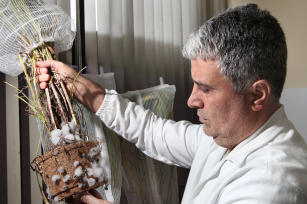Unit
Embrapa Dairy Cattle
Strategies of spittlebug control: plant resistance and evidence of pheromone

Photo: Brigato, Márcio
Spittlebug, Mahanarva spectabilis (Hemiptera: Cercopidae) is capable to cause drastic losses in production and quality of pastures established with grasses. Currently, the use a grass resistant cultivar, to be obtained by means of constitutive antibiosis, is the best spittlebug controlling method. However, the time required for releasing a cultivar after detecting a spittlebug-resistant strain is relatively long. Allied to this, one should take into consideration that the adaptations of some species of spittlebug, with more aggressivity, can promote the breakdown of resistance. Thus, alternative strategies must be investigated as the induction of resistance by tolerance and/or chemical inducers. Moreover, semiochemicals (sex pheromones) involved in intraspecific communication among insects are an alternative to improve use of resistant plant varieties. Since the two strategies are independent, if they are used together a synergism to control insect pests can be promoted. Given the above, this project is evaluating forage resistance and investigating the existence of a sex pheromone for the control of M. spectabilis. Thus, the project will select two genotypes of Brachiaria sp., Pennisetum purpureum and Cynodon sp. developed by Embrapa’s Genetic Improvement Program for resistance to spittlebug, through constitutive antibiosis. In these materials, it will be determined the optimal dose of fertilizer sufficing to promote tolerance to spittlebug. The genotypes selected for resistance through constitutive antibiosis and tolerance will be exposed to chemical inducers (silicon application and nitric oxide). It will also be investigated whether there is a sex pheromone involved in communication between adults of M. spectabilis, through a study of mating behavior and the extraction of chemical compounds released by spittlebug adults (i.e. an evidence of sex pheromone). The results will provide scientific advancement, since new knowledge on control techniques will be generated, aimed at mitigating the problems caused by M. spectabilis, which currently constitute one of the major constraints to the expansion of some forage grass species.
Ecosystem: Atlantic Forest, Cerrados Region
Status: Completed Start date: Mon Jun 01 00:00:00 GMT-03:00 2015 Conclusion date: Wed May 31 00:00:00 GMT-03:00 2017
Head Unit: Embrapa Dairy Cattle
Project leader: Alexander Machado Auad
Contact: alexander.auad@embrapa.br
Keywords: Forrageira, Inseto-praga, resistência induzida, Ecologia Química